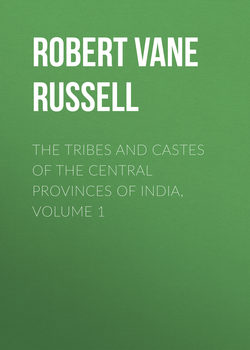Читать книгу The Tribes and Castes of the Central Provinces of India, Volume 1 - Robert Vane Russell - Страница 44
Part I.
Introductory Essay on Caste
Introductory Essay on Caste
41. Derivation of the impure castes from the indigenous tribes
ОглавлениеIt can only be definitely shown in a few instances that the existing impure occupational castes were directly derived from the indigenous tribes. The Chamār and Kori, and the Chuhra and Bhangi, or sweepers and scavengers of the Punjab and United Provinces, are now purely occupational castes and their original tribal affinities have entirely disappeared. The Chamārs and Mehtars or sweepers are in some places of a superior physical type, of comparatively good stature and light complexion;82 this may perhaps be due to a large admixture of Hindu blood through their women, during a social contact with the Hindus extending over many centuries, and also to the fact that they eat flesh when they can obtain it, including carrion. Such types are, however, exceptional among the impure castes, and there is no reason to doubt their general origin from the non-Aryan tribes, which in a few instances can be directly traced. Thus it seems likely that the Kanjars, Berias, Sānsias and other gipsy groups, as well as the Mirāsis, the vagrant bards and genealogists of the lower classes of Hindus, are derived from the Dom caste or tribe of Bengal, who are largely employed as sweepers and scavengers as well as on ordinary labour. The evidence for the origin of the above groups from the Doms is given in the article on Kanjar. Sir H.M. Elliot considered the Doms to be one of the original tribes of India. Again, there is no doubt that the impure Gānda caste, who are weavers, labourers and village musicians in the Uriya country and Chhattīsgarh Districts of the Central Provinces, are derived from the Pān tribe of Chota Nāgpur. The Pāns or Pābs are a regular forest tribe, and are sometimes called Gānda, while the Gāndas may be alternatively known as Pān. But the section of the tribe who live among the Hindus and are regarded as impure have now become a distinct caste with a separate name. The Bhuiya tribe were once the rulers of Chota Nāgpur; they still install the Rāja of Keonjhar, and have a traditional relation to other ruling families. But in parts of Chota Nāgpur and southern Bihār the Bhuiyas living in Hindu villages have become a separate impure caste with the opprobrious designation of Mūsahar or rat-eater. The great Mahār caste of the Marātha country or Bombay are weavers and labourers, and formerly cured hides, like the Chamārs and Koris of northern India. They are regarded as impure and were the serfs or villeins of the Kunbis, attached to the land. An alternative name for them is Dher, and this is supposed to be a corruption of Dharada a hillman, a name applied in Manu to all the indigenous races of India. Though the connection cannot be traced in all cases, there is thus no reason to doubt that the existing impure castes represent the subjected or enslaved section of the primitive non-Aryan tribes.
82
See article Chamār, para. 1.
